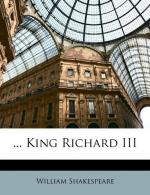|
This section contains 9,037 words (approx. 31 pages at 300 words per page) |

|
SOURCE: “Richard III, Unhistorical Amplifications: The Women's Scenes and Seneca,” in Modern Language Review, Vol. 75, No. 4, October, 1980, pp. 721-37.
In the essay that follows, Brooks investigates the influence of Seneca's Troades on Shakespeare's depiction of the four women in Richard III.
In Richard III, Shakespeare owed little to his chronicle sources for the sensational wooing of Anne, the wailing royal women, and Clarence's dream. Yet though these passages are unhistorical, he had, as with the episode of the faithful groom in Richard II,1 materials and inspiration for them. When investigated, Clarence's dream appears to be an imaginative fusion and re-creation from a range of reading outside the chronicles, with hints coming from Seneca, Golding's Ovid, The Mirror for Magistrates, probably from The Spanish Tragedy, and above all from the Cave of Mammon and the sea-episodes in the first three books of The Faerie Queene, published in 1590, the year...
|
This section contains 9,037 words (approx. 31 pages at 300 words per page) |

|


